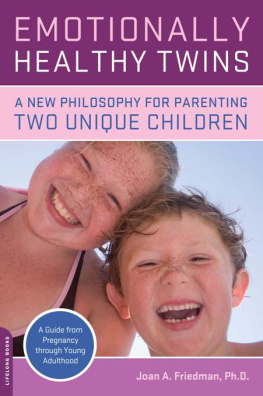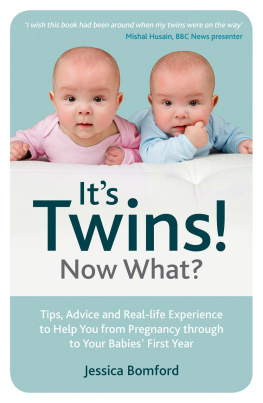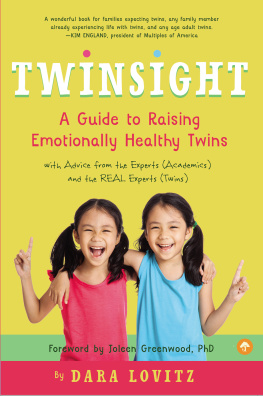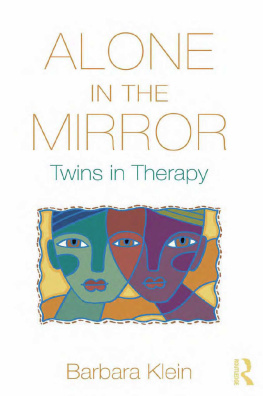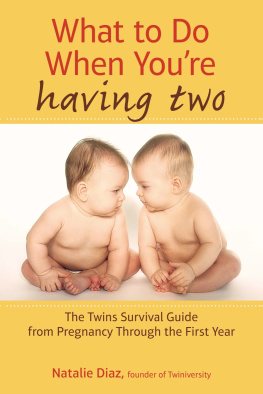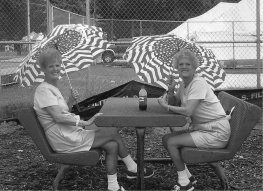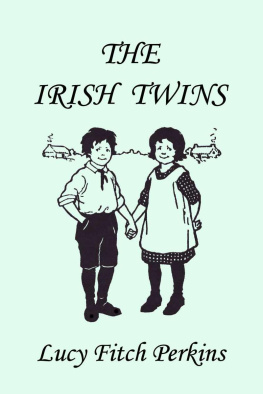RAISING TWINS
What Parents Want to Know
(and What Twins Want to Tell Them)

Eileen M. Pearlman, PH.D.,
&
Jill Alison Ganon

I dedicate this book to my family, with special thanks to the twins in my lifemy sister, Elaine, and my husband, Art.
Eileen M. Pearlman
I dedicate this book to my grandmother, Ada Ganon, and my great-aunt, Miriamloving sisters and best of friends.
Jill Alison Ganon
CONTENTS
A s we prepare this book for publication, a new report by the National Center for Health Statistics, Trends in Twin and Triplet Births: 1980-97, confirms that the rate of multiple births is skyrocketing. The report tells us that from 1980 to 1997 the number of twin births in the United States rose 52 percent (from 68,339 to 104,137). Even more astonishing is the increase in multiple births to mothers in their forties: The twin birth rate rose 63 percent for women between the ages of 40 and 44 and rose almost 1,000 percent for women from 45 to 49 years of age.
More and more children will grow up knowing twins and having twins as friends and neighbors; more and more teachers will have at least one set of multiples in their class each year; more coaches will have twins on their teams; more pediatricians will have twins as patients; more parents will face the prospect of raising children who are multiples; and finally, more children will grow up experiencing the unique joys and challenges of the twin relationship.
Raising Twins is a guidebook for the increasing number of mothers and fathers who set out to have a child and hit the jackpot with twins. This book applies a developmental approach to parenting twins as well as triplets and higher order multiples from toddlerhood on through adolescence and young adulthood.
Why a developmental approach? The answer, as it applies to this book, is very simplewe believe that an understanding of the cognitive, emotional and physical development of twins will be useful not only when your children are very young, but also through the mostly uncharted territory of their older elementary through teenage years.
We start our developmental exploration at the very beginning, with twins not yet born, sharing the intrauterine environment. But this is not a book about twin pregnancy, nor is it a book about raising your infant twins. We include our discussions of very early development because we believe they contribute to a richer understanding of your twins toddlerhood, childhood and adolescence.
Were very pleased to include many chats with twins throughout this book. These Twin Talk segments feature interviews with twins who range in age from 5 to 21. We gave our twin subjects cameras and asked them to photograph each other. Weve included many of those pictures and added a few others from family albums. While we could have included conversations with many twins, we chose to use multiple interviews with a core group of eight sets of twins so that you would have an opportunity to get to know them as they make their appearances throughout the book. We hope parents will read this book with their own twinsand begin their own in house dialogues about sharing, fighting or even advice to parents about raising twins. Weve included an epilogue that features several more interviews as well as a few additional talks with other twins on new topics. We hope you enjoy getting to know these twins as much as we enjoyed our meetings with them.
While our approach is developmental, this is a topic-driven book. Whether you are a seasoned parent of one or more singleton children, or your twins have made you a first-time parent, multiples have a significant impact on the life of your family:
How will you handle school and class placement?
When is it good for twins to share, and when do they need their own toys, friends or time with you?
How can you help your twins to become individuals while supporting their twin bond?
How can you love your twins equally, though not the same?
What do you do when twins mature at very different rates?
What do you do when twins mature at the same rate but have very different needs?
We hope that parents who are in the trenches, dealing with the daily challenges of raising sound, healthy, individuated twins, will use this book on an as needed basis: Parents with preschool-age twins might want to read a little bit about developmental issues for three- and four-year-olds in Chapter Two, Twin Development, and then skip to Chapter Nine, Schooldays, for an overview of the issues relevant to their twins educational needs. New parents of twins will find it useful to thumb through Chapter Three, Being the Parent of Twins, where they will find many suggestions for strengthening their couple relationship as they work together to make a home for their children. Chapter Ten, Teenage Twins, will provide practical tips for seeing twins through the three stages of adolescence. Weve also included a chapter dedicated to the discussion of numerous twin myths. Naturally, we could not include every myth weve heardthat would be another whole bookbut we have chosen to include many myths that are frequently discussed. Think of Raising Twins as a friendly reference book that is there for you and your twins when you need it. We like to imagine that it will live on your nightstand, where it will rise to the top of the pile of books every now and again for many years to come.
Some final thoughts: The focus of this book is twin specific, but we hope families with higher order multiples will also find it useful. As you read Raising Twins youll notice that we alternate the use of gender descriptive pronouns throughout the bookhis or hers, he or she. We do this to avoid the very distracting and awkward use of his/her and he/she throughout our text. It is also worth noting that we have chosen to describe twins as identical and fraternal throughout the book because those are the terms you and your twins will hear and use out in the world. We realize the corresponding terms monozygotic and dizygotic, which we describe and discuss early in the book, are more scientifically accurate, but weve yet to hear a mom tell us she was approached in the mall and asked if her twins were monozygotic or dizygotic.

Twins means playing and reading together. Living together, walking together, and riding together. Thats all.
Brad, 5-year-old fraternal twin boy
TYPES OF TWINNING
W hen done the old-fashioned way (that is to say, in a candlelit room, without the presence of a laboratory technician), a mans sperm meets a womans egg (ovum), and the fertilized ovum enters the uterine cavity and is implanted there. The cells then begin to differentiate. Some form the placenta, while others create the sac made up of two layers: an outer layer (the chorion) and an inner layer (the amnion) in which the embryo (the stage in human development between the ovum and the fetus) will reside throughout its gestation. The cells will continue to develop until the embryo becomes a fetus after 8 weeks gestation. Approximately 28 weeks later, the fetus, now a baby, is delivered into your loving family.
In order for twins to occur, two embryos develop simultaneously in a womans uterus. If we translate the statistics below into the likelihood of a woman in the United States giving birth to twins, we come up with a figure of approximately I in 39 being doubly blessed in the delivery room.
Next page



